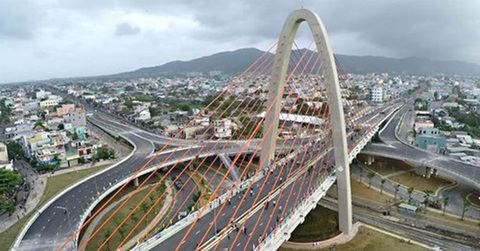
The central city of Da Nang should develop as a unique smart city and a competitive global centre of tourism and services, Prime Minister Nguyen Xuan Phuc said at a meeting to mark the 20th anniversary of Da Nang’s autonomous status directly under the central government. — Photo cafef.vn
The central city of Da Nang should develop as a unique smart city and a competitive global centre of tourism and services, Prime Minister Nguyen Xuan Phuc said at a meeting to mark the 20th anniversary of Da Nang’s autonomous status directly under the central government.
He applauded the achievements of the past 20 years in terms of international integration and reform, the attraction of a high quality labour force, and the city’s development as a draw for business start-ups and as a driving force of economic growth in the central region.
“Da Nang will serve as magnet for foreign direct investment, information technology and skilled labour force. It should be a front-runner in business reform, education and business start-ups,” he said, adding that the city should develop 45,000 enterprises by 2020.
The PM also said Da Nang, situated in central Viet Nam, has to build links with other localities in the region and serve as a core of the central region’s socio-economic development. He suggested the city focus on the quality of its business environment in order to be competititce with other urban centres in the world.
Phuc noted that 2017 will present the city of one million people with a great opportunity, as well as a challenge, when it hosts the Asia-Pacific Economic Cooperation (APEC) Summit later this year and other APEC events.
The city’s party secretary, Nguyen Xuan Anh, said Da Nang had turned from a third-class urban locale into a first-class city under the central government between 1997 and 2017. He said the city earned total revenues of VND54 trillion (US$2.4 billion), contributing VND19 trillion ($840 million) to the State budget in 2016.
“The city has seen a rapid development in tourism and services, from 61 hotels with more than 2,000 rooms in 1997 to 585 hotels with 21,000 rooms after 20 years,” Anh said. “Da Nang is now four times larger than in 1997, with a total area of 21,300ha.”
Anh, who is also chairman of the city’s People’s Council, said the city had been ranked on top of the Provincial Competitiveness Index (CPI) every year since 2010, and was a leader in administrative reform and information technology.
He said the city’s downtown, which was in the past connected with its beach destinations on Son Tra peninsula by two downgraded bridges, is now accessible through nine modern, attractively designed bridges.
In 2012, it was selected for a Low-Carbon Model Town Project at the 44th APEC energy meeting in Washington DC. The city had been developing low-carbon model projects, including battery powered bicycles, technologies to curb greenhouse gas emissions and renewable energy sources, a metro system and Rapid Bus Transit (BRT).
The city had already cut 12,000 tonnes of carbon emissions during a pilot project between 2008-11.
The city hosted 5.6 million tourists, 1.65 million of them foreigners. — VNS
First 2017 cargo ship docks at Da Nang port
The Tien Sa Port in Da Nang welcomed the Panamanian-flagged Bundi Ipasa on Sunday, the first cargo ship to dock in the biggest port in central Viet Nam this year.
The Da Nang port also launched the operation of its third quay container crane (QCC) on January 1.
General director of Da Nang port, Nguyen Huu Sia, said the company plans to handle 7.6 million tonnes of cargo in 2017 including 360,000 TEUs (twenty-foot equivalent unit).
“Da Nang port is a major logistics centre in central Viet Nam, with a 13 per cent growth annually. The port has 24 cargo ship arrivals every week, and container ships accounts for 60 per cent of our capacity,” Sia said. “We plan to build a new Lien Chieu Port as a major cargo port, while Tien Sa port will become the main port for cruise ships in the coming years,” he said.
He said the port also hosted 73 cruise ships with 135,000 tourists visiting the city in 2016.
The Da Nang port company also started upgrading Tien Sa Port in 2016 with a total investment of VND1.1 trillion (US$49.3 million).
According to Viet Nam’s seaport system development plan towards 2020, Da Nang port is destined to become one of the key gateways to the East Sea from the sub-Mekong region. — VNS